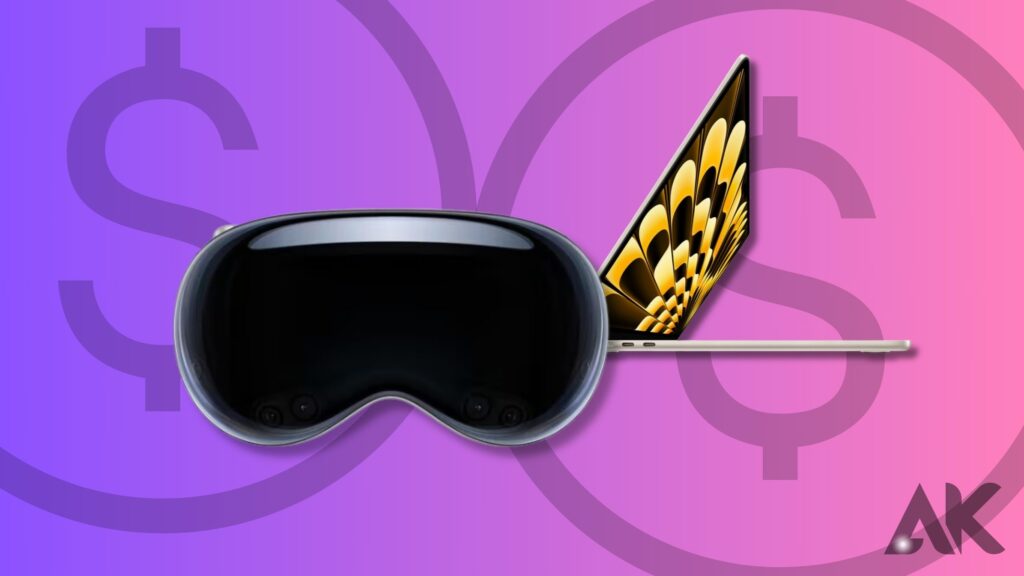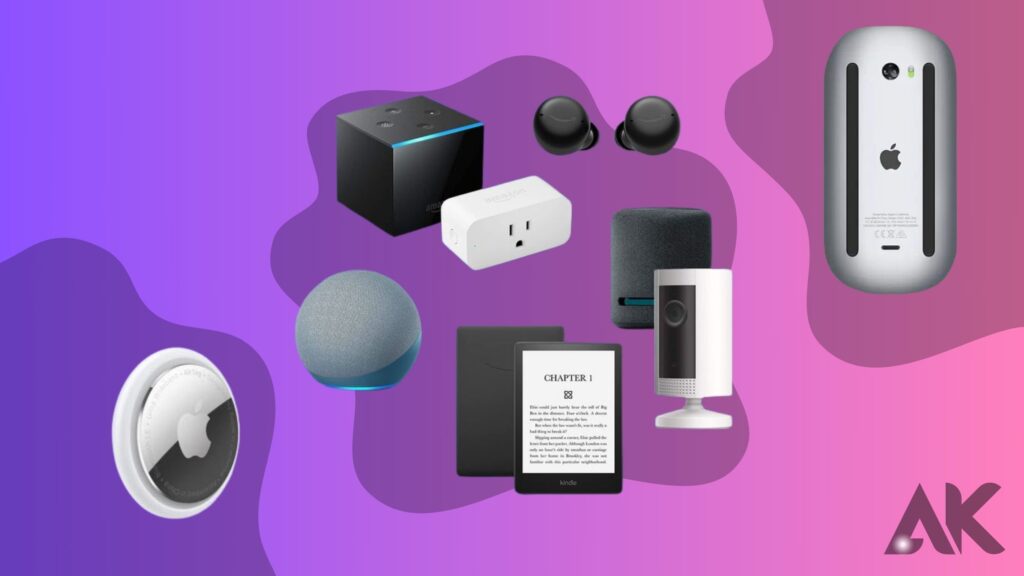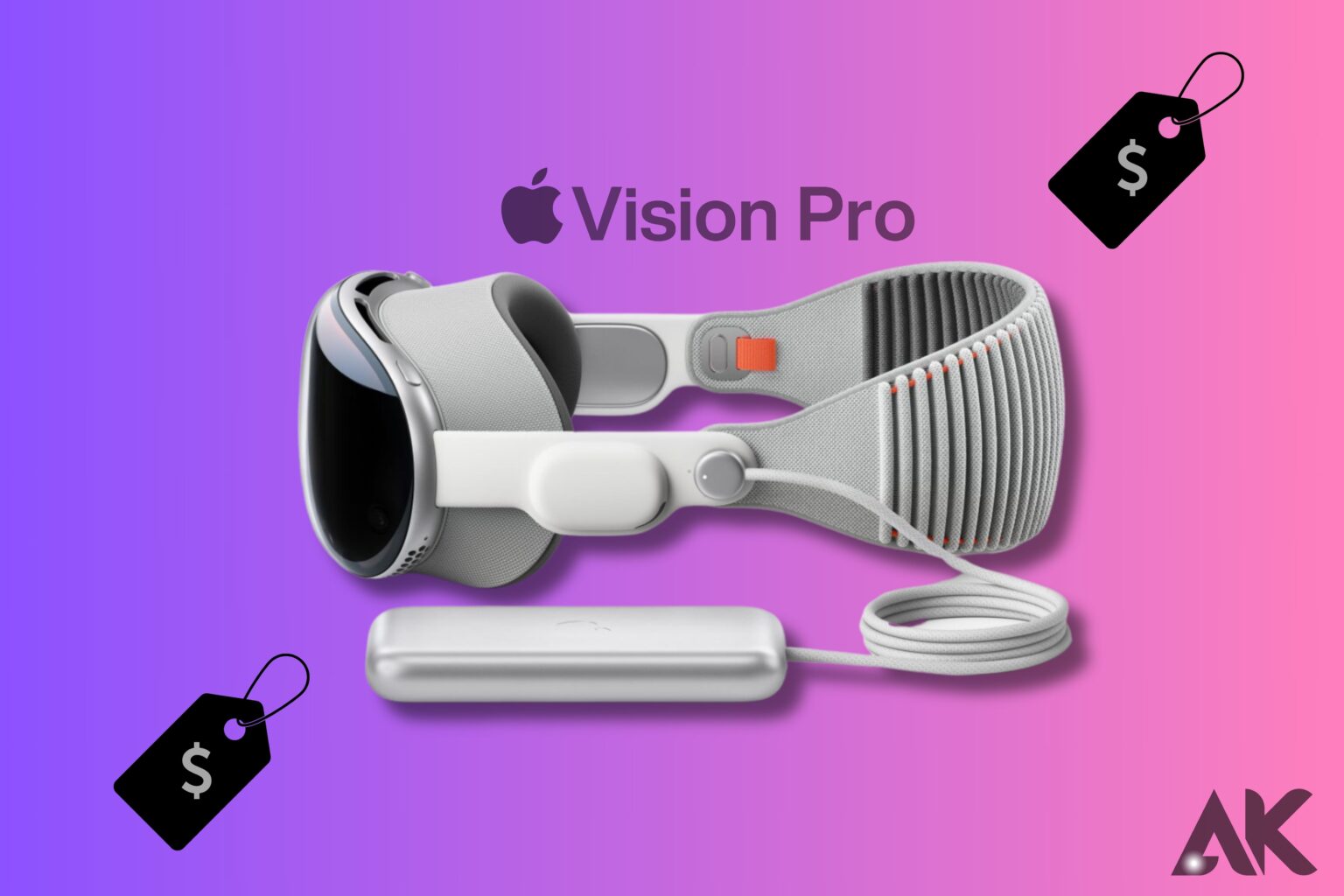Explore the hidden features and reasoning behind the high pricing of Apple’s Vision Pro. Explore the features that set Apple’s flagship product apart from the competition, including state-of-the-art technology, unmatched design, and flawless integration. Delve into the meticulous attention to detail, cutting-edge capabilities, and unparalleled ease of use that characterize the Vision Pro. Come with us as we investigate the reasons behind the high price tag and see why Apple’s Vision Pro is considered by many to be the pinnacle of consumer sophistication and luxury throughout the globe.
Vision Pro’s price is comparable to that of a high-end Mac.

Even though it’s priced premium, Apple’s Vision Pro isn’t their most costly computer. The $6,999 Mac Pro, an additional Apple computer that costs over twice as much, received its first significant update since 2019 during Monday’s WWDC. Not everyone should buy Apple’s modular desktop powerhouse since it was made for experts, not regular people.
Setting up even the most basic MacBook Pro with all the bells and whistles may make it cost more than most people expect. A 16-inch MacBook Pro with 32GB of unified memory, 1TB of storage, and Apple’s M2 Max CPU would set you back $3,499, much like Vision Pro.
The price of Vision Pro probably reflects the many years of research and development that went into making it. The R1 chip, which handles data from the twelve cameras, five sensors, and six microphones included in the headset, is one example of the innovative technology that Apple had to create due to the device’s complete departure from the Mac, iPhone, and iPad. During the WWDC keynote, Mike Rockwell—who is VP of Apple’s technology development group—even went so far as to say that the firm filed more than 5,000 patents when developing Vision Pro. The work put into the headgear is evident, as CNET’s Scott Stein said after being pleased with the UI, visual clarity, and fidelity.
“The engineering and depth of engineering in it is mind-blowing,” Cook said during the Good Morning America interview. You’re getting more than 4K on both eyes. Plus, there is a cost associated with it. Doing it incurs some kind of expense.
The Vision Pro’s pricing may be harder to take than that of the MacBook Pro or Mac Pro due to a significant distinction. Both of those items have been around for a while and have shown their worth to the creative types who are ready to shell out the cash for them. But Vision Pro is a whole new category of products, so nobody knows what it is yet. Except for a small group of journalists who were given a demo by Apple, few individuals outside of Apple’s campus have used it, and it hasn’t shown its worth just yet.
Apple Vision Pro may seem expensive, but its cost isn’t what you might expect.
It would seem that the Vision Pro is superior to competing headsets. If you’re OK with wearing ski goggles, they should look fine on your head. In terms of technology, it’s head and shoulders beyond anything else we’ve encountered. Plus, it’s supported by Apple’s robust ecosystem, so you should expect to see hundreds of applications for it in about a year.
Online comments, nevertheless, show that most individuals are fixated on the cost. As it should be: When compared to similar headsets, including the $499.99 Quest 3 and the $999.99 Meta Quest Pro, the Vision Pro’s price tag of $3,499 is astronomical. The Vision Pro from Apple is so expensive that I can see many virtual reality and augmented reality fans recoiling in horror. Honestly, it’s not even in the same league. The stock price of Apple fell precipitously during the Vision Pro launch as if to signal that the market does not expect such a pricey headset to significantly boost Apple’s bottom line.
It may not be what you expect, but there’s a good reason why the price is expensive. Indeed, it is likely that the Vision Pro incurs astronomical production expenses. It must have cost Apple a pretty penny to manufacture this behemoth, what with the M2 and new R1 chips inside, as well as a dozen cameras and a plethora of sensors.
However, I believe that the true motivation for Apple’s release of such a robust and costly headset is that it is not aimed at the general public. Only programmers and maybe a small group of fans will be able to use this gadget. Surely Apple isn’t banking on selling millions of them at $3,499 each.
New tech gadgets usually get cheaper over time.

The products of a technology’s first generation are often more costly and have fewer features than those of subsequent generations. In 2007, there was only one model of iPhone, and it cost $499 (or about $749 in 2023 dollars) before inflation. It had one camera, fifteen applications, and a pitiful 4 GB of storage. Apple now offers a variety of iPhones at various pricing levels, but the top-of-the-line iPhone 14 Pro will still cost $1,000 or more.
The $429 iPhone SE is one example; it contains a fingerprint scanner, a 4.7-inch screen (far bigger than the original’s 3.5-inch display), 16 times the storage of the entry-level first iPhone, and a plethora of other technology that wasn’t commonplace in 2007. Plus, when compared to the first iPhone, the iPhone SE will be almost $320 less expensive in 2023.
The development of VR goggles could provide a more direct parallel. The first Oculus Rift, which debuted in 2016, required a powerful computer to function and cost $599. However, the new WiFi Meta Quest 2 is available for $300, which is half the price.
What I mean is that technology improves and becomes more accessible as time goes on. I understand it; the current generation of Apple’s headgear won’t likely become as ubiquitous as the iPhone or Apple Watch due to its price.
Still, it’s possible that’s not the point—at least for the time being. Apple is aiming to lay the groundwork for what it thinks will be the next big step in PC innovation with Vision Pro. That’s more important than making a million dollars on launch day, and no amount of money will make that kind of change happen quickly. Most people probably won’t purchase the version of Vision Pro that Apple releases next year.
Microsoft’s HoloLens 2 is the same price as Vision Pro.
Before Vision Pro, Microsoft had HoloLens, a head-mounted computer that aimed to revolutionize our workflow by superimposing digital visuals onto the actual environment. Similar to Apple’s Vision Pro, the second iteration of HoloLens came out in 2019 for $3,500. The first one came out in 2015.
Having said that, it does make the pricing of Vision Pro more reasonable. The HoloLens and Apple’s new head-mounted computer are similar, but there are a few key distinctions to keep in mind. It is evident from Microsoft’s HoloLens 2 website that the corporation views this device more as a corporate gadget than a home PC.
Microsoft is now promoting the HoloLens for its applications in manufacturing, construction, healthcare, engineering, and education, rather than its original positioning as the next generation of computing. Because of this, buying a HoloLens 2 is more akin to investing in new machinery for businesses and organizations than in a new computer. People who work, view films, and participate in FaceTime chats regularly may be Apple’s target audience for Vision Pro.
Conclusion
Apple’s Vision Pro, a premium headset, is priced at $3,499, compared to competitors like Meta’s Quest 3 and Meta Quest Pro. The headset is designed for developers and enthusiasts, not the masses. Its high price is likely due to its advanced technology, including an M2 and R1 chip, 12 cameras, and sensors. Despite its high price, the Vision Pro is not the most expensive computer Apple sells, as the $6,999 Mac Pro is designed for professionals. The headset’s engineering research and development efforts are evident in its high-quality video and audio experience.
FAQS
Why is the Vision Pro so expensive?
The production costs of the Vision Pro and an early emphasis on reaching professionals like developers—who could improve the product with additional apps—are to blame for the high price, according to analysts.
Will the price of the Apple Vision Pro drop?
With 256 GB of storage, the Apple Vision Pro costs $3,400. Even though this is Apple’s first foray into a new product category, the price is sure to reduce with each subsequent version of the wearable, so it’s not too steep.

